Birthmarks: Signs and symptoms
Pictures of different birthmarks
If you’ve already read “What exactly is a birthmark?,” you already know birthmarks come in many shapes and sizes. Here you’ll see what the different types of birthmarks can look like.
Strawberry hemangioma
Medical name: Superficial infantile hemangioma
What it looks like: The birthmark usually looks like a strawberry-colored lump that feels firm and rubbery. Sometimes, instead of a seeing a lump, you may find a strawberry-colored patch or patches on your child’s skin.
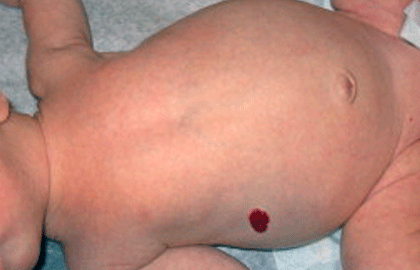
Whether a lump or patch, this birthmark tends to grow quickly, usually until the child is 4 to 6 months old. Some grow for a longer time. When a strawberry hemangioma stops growing, it may stay the same or start to shrink.
In time, all strawberry hemangiomas shrink. As it shrinks, the color changes to slate gray. The birthmark also begins to soften.
When the birthmark shrinks, the skin may break down, causing pain. If this happens, see your child’s dermatologist. The right wound care can help speed healing and eliminate the pain.
Where it usually develops on the body: Most occur on the head or neck, but this birthmark can develop anywhere on the skin or moist tissue inside the mouth or anus.
Will it go away? Yes, it usually goes away on its own, leaving little evidence that it was ever there. About 10% disappear by the age 1 and, 90% are gone by the time a child is 10 years old.
Deep hemangioma (he-man-gee-oh-ma)
Medical name: Cavernous infantile hemangioma
What it looks like: This birthmark looks like a lump that sits deep in the skin. It may be skin colored or have a bluish-purple color as shown here. You may see thin red lines, which are visible blood vessels. When you touch this birthmark, it often feels warm and firm.
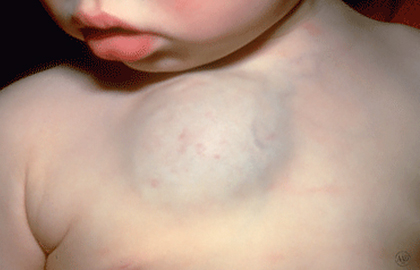
This birthmark can grow quickly and grow for up to a year. Sometimes, the growth stops suddenly. Other times, it slows.
While it's growing, a deep hemangioma can be painful. Some break open and bleed.
If this happens, make an appointment for your child to see a board-certified dermatologist.
Where it usually develops on the body: Anywhere on the skin.
Will it go away? Most fade on their own, but it takes time. About half disappear by 5 years of age. Nearly 90% will be gone by the time a child is 10 years old. As it fades, it can leave a light spot or scar on the skin.
Salmon patch
Medical name: Nevus simplex
What it looks like: You’ll see a flat, pink, red, or salmon-colored spot or patch.
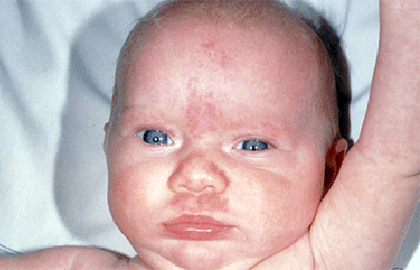
If you gently press on this birthmark, the color tends to fade. The color becomes more noticeable when your baby cries, becomes overheated, or feels irritated.
Some babies have a few spots or patches, as shown here. When a salmon patch appears on the face, it’s often referred to as an angel’s kiss. On the back of the neck, people often call this birthmark a stork’s bite.
Where it usually develops on the body: Usually the face or the back of the neck, but it can appear elsewhere on the skin.
Will it go away? On the face, this birthmark tends to disappear between 1 and 3 years of age. When it appears on the back of the neck (stork’s bite) or elsewhere, it may fade but not disappear.
Café-au-lait (café-oh-lay) spot
Medical name: Café-au-lait macule
What it looks like: This flat spot is darker than the rest of your child’s skin. It has an easy-to-see border and is the same color throughout. The color ranges from that of coffee with milk on fair skin (shown here) to the color of black coffee on dark skin. The size varies greatly. It can be the size of a freckle or cover a large area of skin.
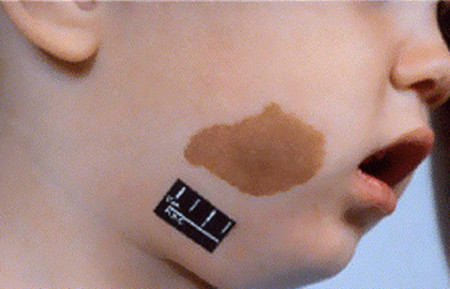
Most children have one spot, but some kids have more.
If your child has six or more café-au-lait spots or you see spots that look like freckles developing around a café-au-lait spot, it’s time to see a dermatologist.
Where it usually appears on the body: Buttocks, but it can appear anywhere on the skin, including the face (shown here).
Will it go away? No. This spot remains on the skin for life.
If your child has a café-au-lait spot in a visible place, a dermatologist can tell you whether treatment can help.
Mole
Medical name: Congenital melanocytic nevus

What it looks like: A mole can appear on the skin as a small spot or cover a large area of skin. The mole may feel smooth, warty, or like cobblestones.
Moles come in many colors, but most are brown or tan.
Where it usually appears on the body: Like moles that appear later in life, this mole can appear anywhere on the skin.
Will it go away? A few disappear, but most remain on the skin for life. Because melanoma, the most-serious skin cancer, can develop in a mole, this birthmark should be checked by a dermatologist.
Mongolian spot
Medical name: Dermal melanocytosis
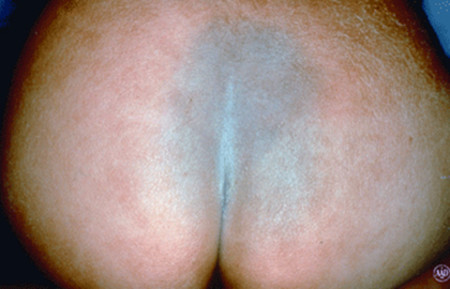
What it looks like: Often looking like a bruise, this birthmark may be light blue, dark blue, or blue gray.
A baby may have one spot or several. Each spot can vary greatly in size.
This birthmark occurs in all races. It’s least common in people who have white skin and most common in Asians.
Where it usually appears on the body: Most appear on the lower back or buttocks, but it can show up anywhere on the skin.
Will it go away? These often go away by the time a child is 3 to 5 years old. A few people still have this birthmark as adults.
Port-wine stain
Medical name: Nevus flammeus
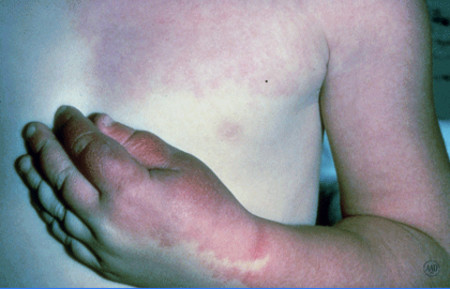
What it looks like: At birth, you’ll see a spot(s) or patch(es) that can be pink, red, or purple.
As the child grows, so will this birthmark. In time, the birthmark tends to thicken and darken. As it thickens, the texture can change. Ridges may develop. Sometimes, the birthmark feels like cobblestones on the skin.
Where it usually develops on the body: A port-wine stain usually develops on the face; however, it can appear anywhere on the skin.
Will it go away? Without treatment, this birthmark remains on the skin for life. Mikhail Gorbachev, the former president of the Soviet Union, has a port-wine stain.
Nevus sebaceous (knee-vus seh-bay-ceous)
Medical name: Organoid hamartoma
What it looks like: What you see varies with the child’s age.
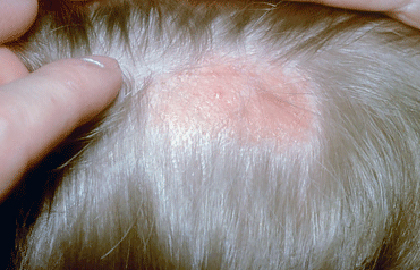
When it develops on the scalp of a newborn, this birthmark often looks like a slightly raised, hairless (or nearly hairless) patch. Your baby’s hair will grow around it, as shown in the picture above.
As your child grows, this birthmark may stay the same or change. It’s most likely to change during the teen years. It may thicken. You may notice the birthmark changes color, becoming slightly yellow or orange. The surface can feel pebbly or warty.
Where it usually develops on the body: This birthmark usually appears on the scalp or face. Occasionally, it develops on the neck or another area of the body.
Will it go away? This birthmark can change, but it doesn’t go away.
White spot
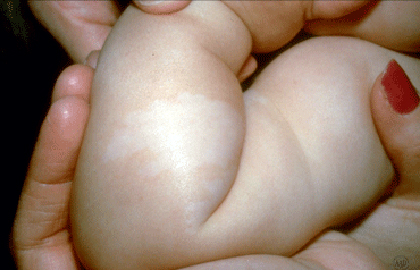
Medical name: Hypopigmented macule
What it looks like: Many people call this a white spot, but this birthmark is often an area of skin that has less color than the baby’s surrounding skin. This spot can be raised or flat. It may be round, oval, or another shape. Some are leaf shaped.
Where it usually appears: Most develop on the chest, abdomen, back, or buttocks. They can also appear anywhere else on the skin.
Will it go away? Most disappear.
Related AAD resources
Images
Images 1,4: Images used with permission of the Journal of the American Academy of Dermatology.
J Am Acad Dermatol. 2008;58:S16-22.
J Am Acad Dermatol. 1999;40:877-90.
Images 2,3,5,6,7,8,9: Images used with permission of the American Academy of Dermatology National Library of Dermatologic Teaching Slides.
References
American Academy of Dermatology, “Red, white and brown: Defining characteristics of common birthmarks will determine type and timing of treatment.” News release issued Feb 4, 2011.
Barnhill RG and Rabinovitz H. “Benign melanocytic neoplasms.” In: Bolognia JL, et al. Dermatology. (second edition). Mosby Elsevier, Spain, 2008:1713,1720-3.
Enjolras O. “Vascular malformations.” In: Bolognia JL, et al. Dermatology. (second edition). Mosby Elsevier, Spain, 2008:1582-5.
Garzon MC “Infantile hemangiomas.” In: Bolognia JL, et al. Dermatology. (second edition). Mosby Elsevier, Spain, 2008:1567-8.
McCalmont TH. “Adnexal neoplasms.” In: Bolognia JL, et al. Dermatology. (second edition). Mosby Elsevier, Spain, 2008:1695-6.
 Atopic dermatitis: More FDA-approved treatments
Atopic dermatitis: More FDA-approved treatments
 Biosimilars: 14 FAQs
Biosimilars: 14 FAQs
 How to trim your nails
How to trim your nails
 Relieve uncontrollably itchy skin
Relieve uncontrollably itchy skin
 Fade dark spots
Fade dark spots
 Untreatable razor bumps or acne?
Untreatable razor bumps or acne?
 Tattoo removal
Tattoo removal
 Scar treatment
Scar treatment
 Free materials to help raise skin cancer awareness
Free materials to help raise skin cancer awareness
 Dermatologist-approved lesson plans, activities you can use
Dermatologist-approved lesson plans, activities you can use
 Find a Dermatologist
Find a Dermatologist
 What is a dermatologist?
What is a dermatologist?